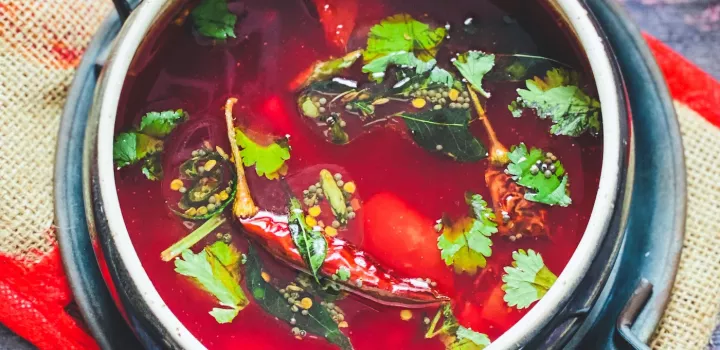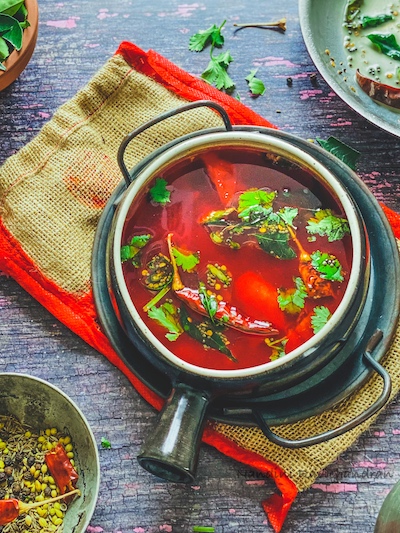
How to Make Rasam
The tart, subtly spiced broth packs flavor and health benefits.
Health-Supportive Culinary Arts student Nandini Ravichandran shares her recipe for the South Indian rasam, a specialty she grew up with.
Kitchens are always brimming with possibilities, and traditional Indian kitchens extend beyond feeding to healing. Growing up, it was very rare that we would go to a hospital for common ailments – my mother always had a trick up her sleeve and deftly used spices and concoctions to treat sickness. Cumin seeds in warm water could cure an irritated stomach, soaked fenugreek seeds helped with menstrual cramps, turmeric in hot milk with a pinch of black pepper boosted general immunity (eons before the age of golden lattes!). We chewed on a clove to soothe an achy tooth or applied a paste of fresh turmeric as an antiseptic for all the bruises from childhood accidents - everything in the kitchen had a role to play in our daily body care. A true homage to the notion that we are what we eat, traditional Indian kitchen wisdom believes that body care is about making daily adjustments to our diet in response to weather, illness, our surroundings and other external factors.
 The food that is front and center in a South Indian kitchen, when it comes to its healing prowess, is the humble rasam, a dish that is said to have originated to treat a sick royal prince. Befitting, rasam is basically a broth that is characteristically tart (usually using tamarind as the souring agent), subtly spiced, and in most cases, made with minimal ingredients. It is a staple in South Indian households (and like many Indian foods, while its name varies by states, the essence is more or less the same).
The food that is front and center in a South Indian kitchen, when it comes to its healing prowess, is the humble rasam, a dish that is said to have originated to treat a sick royal prince. Befitting, rasam is basically a broth that is characteristically tart (usually using tamarind as the souring agent), subtly spiced, and in most cases, made with minimal ingredients. It is a staple in South Indian households (and like many Indian foods, while its name varies by states, the essence is more or less the same).
Rasam was my mother’s weapon of choice in her kitchen apothecary arsenal. Whether it was a common cold, sore throat, stomach ache, frayed nerves or almost any other known malady, there was nothing that a piping hot bowl of rasam couldn’t cure. And I happily complied. I am not sure if it was actually medicinal, but a bowl of rasam was always the antidote that my mother promised it to be. The dish is a piquant combination of the sweetness of ripe tomatoes, the pucker-inducing tartness of tamarind, the fragrance of carefully chosen spices, and the exotic nuttiness of whole spices and curry leaves tempered in ghee and scattered on top.
As I delve academically into the healing properties of foods in the Health-Supportive Culinary Arts program at ICE, I can confirm that the halo around rasam's benefits wasn’t just homemaker wisdom. It wasn’t just the placebo effect that instantly fixed me up from whatever was ailing me. The composition of rasam is innately connected to health.
Rasam ticks at least three of the six rasas (tastes) that Ayurveda posits as being essential to overall well-being and health. I am no expert on Ayurvedic wisdom, but I've read that at least some elements of the six rasas – sweet, sour, salty, bitter, astringent and pungent – should be present for a food to fully benefit the body. And rasam is sweet, salty and sour – variations may even account for some of the other rasas.
The ingredients for rasam are specifically chosen for their nutritional value. According to cookbook author Usha Prabhakaran (she has chronicled 1,000 ways of making rasam in her upcoming book), there is a reason for each of the spices that go into making the podi (spice powder) that adds body and flavor to rasam. Black pepper is good for immunity, cumin helps with digestion, mustard seeds and fenugreek seeds have antioxidant properties, and coriander seeds are anti-inflammatory. Tamarind, which lends rasam its characteristic tartness, also has anti-inflammatory and antioxidant properties, and ghee, which is used for tempering (and really brings the whole dish together), is a rich source of vitamins, healthy fats and antioxidants.
Each building block of the flavor bomb that is rasam has unique healing properties – so it is no wonder that rasam is the magic remedy that it is touted to be. It is the perfect dish for all seasons and all reasons. When winter blues get you down, have some spicy, peppery rasam to perk you up. If you are recovering from a cold or on the edge of one, have some garlicky rasam to open your congested sinuses. Or make yourself a rich tomato rasam just because you deserve it. Sip it like a soup, mix it with some overcooked rice or enjoy it as you fancy. Rasam will always engulf you in the warmest of hugs.
A few key culinary notes (all of which are essential for that perfect rasam):
Your hands are your best friend: Don’t be afraid to get hands-on to assemble rasam. Crush the tomatoes, curry leaves and cilantro with some salt and the tamarind extract – this will bring out the maximum flavor in the dish.
Roast your spices for rasam powder: My mother sends me the key ingredient from India. She laboriously dries the whole spices in the grueling Indian sun and gets them ground at a nearby specialty spice mill, but it is very easy to make the spice powder at home. However, make sure to roast the whole spices before powdering them – this will release the flavor in the spices. If the spices burn in the process, throw it out and redo.
Don’t let your rasam runneth over: When it is about to boil, take the rasam off the heat, garnish with the tempered spices and let the broth rest (closed) for at least 5 minutes before eating.
Don’t skimp on some ingredients: I don’t believe in buying ingredients for single-use, but just in this case, if you can, I urge you to buy some ghee and curry leaves (if you don’t use them in your regular cooking). These two ingredients really elevate the flavor of a rasam – the nuttiness of curry leaves and spices tempered in ghee bring the whole dish together. Besides, both ghee and curry leaves have a variety of uses – so they will not go to waste.
Ghee is available in many supermarkets now, and curry leaves are generally found in specialty Indian food markets. If you cannot consume ghee for dietary reasons, you can use oil for the tempering. Use grapeseed oil or sunflower oil as opposed to olive oil (as the flavor from olive oil may be overpowering).
If it is burnt, throw it out. The tempered spices and curry leaves added at the end of the cooking process are rasam’s crowning glory – that extra flavor layer that ties the whole dish together. Add the spices and curry leaves in the following order: Once the pan is hot, add the mustard seeds and let them sputter. Then add the red chilies, cumin seeds and curry leaves. I also add a pinch of asafoetida (hing) before adding the curry leaves. If the spices burn in the process, throw the whole thing out and make it again. It is worth spending the extra few minutes for perfectly tempered spices.
Recipe
Beetroot and Carrot Rasam Recipe
Ingredients
- 2 tablespoons beetroot, julienned
- 2 tablespoons carrot, julienned
- 2 medium tomatoes, roughly chopped
- 1 small lemon-sized ball of tamarind (use tamarind pods, not paste)
- 400 mililiters water
- 1 1/2 tablespoons rasam spice powder (see directions below)
- 2-3 sprigs cilantro, roughly chopped
- 5-7 curry leaves, roughly torn
- 1 bird’s eye chili, slit in middle, optional
- Salt, to taste
- 1/2-1 teaspoon lemon juice, optional
For the spice powder:
- 1 teaspoon oil (I use sunflower or grapeseed oil)
- 2 teaspoon coriander seeds
- 1 teaspoon cumin seeds
- 1/2 teaspoon black peppercorns (reduce if you desire less spice)
- 2-4 dried red chilies (per desired spice level)
- 1 teaspoon toor dal (pigeon peas)
- 1/2 teaspoon chana dal (Bengal gram)
- 1/2 tsp Turmeric
- 5-7 curry leaves
- 1 pinch asafoetida, optional
For garnish and tempering:
- 1 teaspoon ghee
- 1 teaspoon mustard seeds
- 1-2 dried red chilis
- 1/2 teaspoon cumin seeds
- 1 pinch asafoetida, optional
- 1-2 sprigs cilantro, roughly chopped
- 8-10 curry leaves
Directions
For the spice powder:
- Heat ½ tsp oil in a sauté pan and roast the dals (toor dal and chana dal) on low heat. Roast until dals change color and are aromatic. Transfer the roasted dals to a plate.
- In the same sauté pan, add the coriander seeds followed by the chilies and roast until they are aromatic and crispy. Transfer to the plate with the dals.
- In the same pan, now add cumin seeds and black peppercorns. Roast for 2 minutes and set aside in the same plate as the dals and other spices.
- Heat the remaining oil in the same pan and add the curry leaves and asafoetida (if using). Fry them until they are crispy and set aside with the other ingredients. Add the turmeric to this mixture and let it cool.
- Once cool, grind to a fine powder (I use a spice grinder for this). Store any spice powder remaining after use in a clean dry glass jar.
For tempering:
- Heat the ghee in a sauté pan or a butter warmer.
- Once the ghee is hot, add the mustard seeds and let them pop and sputter (should be a matter of seconds).
- Once the mustard seeds sputter, add the red chilis, cumin seeds, asafoetida (if using) and curry leaves (in that order). Turn off the heat immediately after adding the curry leaves and toss to coat. The curry leaves will crisp up from the residual heat.
- Set aside and use to garnish Rasam as described below.
For the rasam:
- Soak the tamarind in 200 ml (warm) water and set aside.
- Boil the beetroot and carrots in 200 ml water. Strain the cooked vegetables and reserve the cooking liquid.
- Puree 1 tbsp each of beetroot and carrot (with some of the cooking liquid, if needed) – retain the rest for garnish.
- Extract the juice from tamarind and reserve the water. Discard the tamarind pulp.
- Add the pureed beetroot and carrot to the tomatoes in a medium saucepan, then add the curry leaves, salt, tamarind water, reserved liquid from cooking the beetroot and carrots and bird’s eye chili (if using). Crush the tomatoes with the rest of the ingredients with your hands. Cook the mixture on low heat for 5-7 minutes.
- Add 1 ½ tbsp of the freshly prepared spice powder (see method above) and cook on medium-low heat until the Rasam comes to a gentle boil.
- As soon as it starts boiling, take the Rasam off the heat. Add the chopped cilantro, the reserved beetroot and carrot, tempered spices and curry leaves (see tempering method above). Adjust seasoning, as required and add lemon juice per taste (optional).
- Cover and let it rest for 5 minutes before serving. Serve hot. Enjoy by itself as a soup or with some rice.
Study more medicinal food in Health-Supportive Culinary Arts.


Add new comment